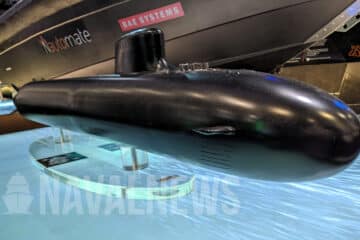BAE Systems press release
BAE Systems’ advanced radio-frequency sensor enables LRASM to strike specific, high-value maritime targets from long range in aggressive electromagnetic warfare environments.
“We’re advancing the state of small electronic warfare systems through our efficient LRASM seeker design, which delivers discriminating capabilities at an affordable cost. Our seeker enables the U.S. Navy, U.S. Air Force, and our allies to find the proverbial needle in the haystack with high-performance, multi-mission missiles.”
Larry Glennon, Small Form Factor product line director at BAE Systems
The LRASM provides warfighters with a capable precision strike weapon intended for use from airborne platforms including B-1B Lancer bombers, F/A-18E/F Super Hornet fighters, F-35 Lightning II fighters, P-8A Poseidon maritime patrol aircraft, and surface vessels via the Mark 41 Vertical Launching System. The missile’s diversity of launch platforms, survivability, range, and lethality provide critical capability and flexibility to warfighters – allowing them to project strength and strike when necessary.
Work on BAE Systems’ seeker takes place at the company’s advanced manufacturing facilities in Wayne, N.J.; Greenlawn, N.Y.; and Nashua, N.H.
-End-
About AGM-158C LRASM anti-ship missile

LRASM is designed to detect and destroy specific targets within groups of ships by employing advanced technologies that reduce dependence on intelligence, surveillance and reconnaissance platforms, network links and GPS navigation in electronic warfare environments. LRASM will play a significant role in ensuring military access to operate in open ocean/blue waters, owing to its enhanced ability to discriminate and conduct tactical engagements from extended ranges.
The AGM-158C is derived from the Joint Air-to-Surface Standoff Missile Extended Range (JASSM ER). An anti-jam GPS guidance system, radio frequency sensor (RFS), and an infrared sensor support guidance and targeting. Once launched, LRASM guides to an initial point and employs onboard sensors to locate, identify, and provide terminal guidance to the target.
BAE Systems’ long-range sensor and targeting technology enables LRASM to detect and engage protected ships in all weather conditions, day or night, without relying on external intelligence and navigation data.
Armed with a 1,000 Lbs (454 kg) penetrating blast fragmentation warhead, LRASM is low observable and likely has a range comparable with JASSM ER (around 500 nautical miles).
LRASM is designed to meet the needs of U.S. Navy and U.S. Air Force Warfighters in contested environments. The air-launched variant provides an early operational capability for the U.S. Navy’s offensive anti-surface warfare Increment I requirement.
LRASM Achieved EOC with the U.S. Navy’s F/A-18E/F Super Hornet in December 2019 and may soon find its way aboard the B-52 bomber of the U.S. Air Force. The U.S. Navy conducted a live firing of a LRASM during Valiant Shield in September 2020.






